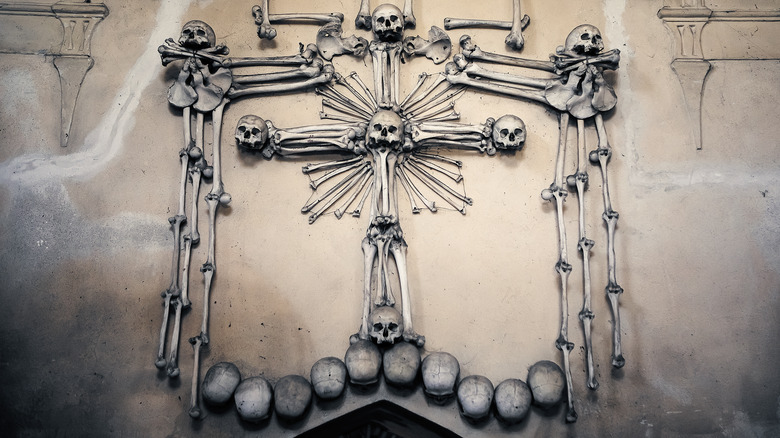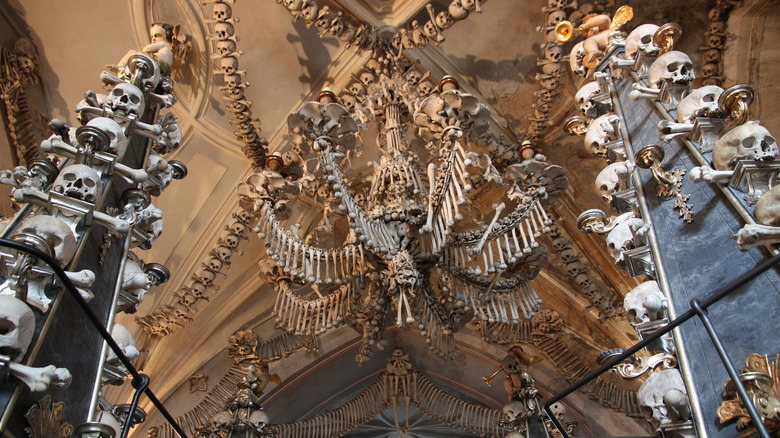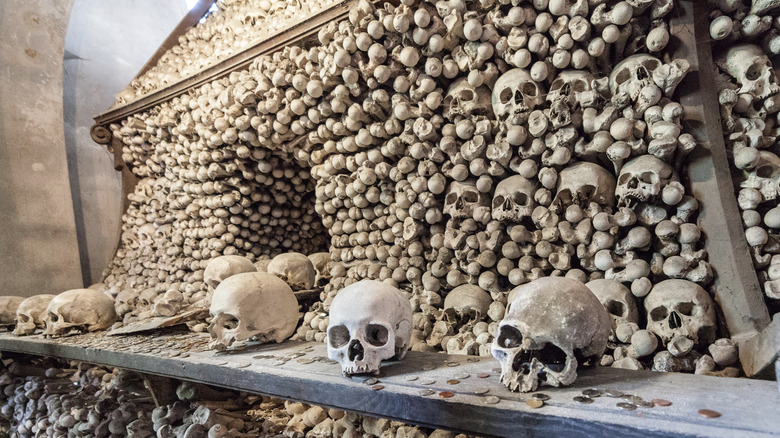The Disturbing Beauty Of Sedlec Ossuary, The Bone Church Of Prague
You know what's pretty awesome? Bone churches. Not that they're common or anything, or else they might lose their macabrely decorous impact. Bones in churches, however, are totally normal. Every Catholic church, in fact, contains some relic — the bone of a saint — shipped over from the Vatican. So when priests behind an altar lift the host at mass and intone their prayer? They're standing behind a reliquary, as The Leaven outlines. Bones kept in tombs under churches are also totally common, as are bones in graves in cemeteries around churches. Basically, we're saying that churches are all about 'dem bones.
But what about a bone church, you ask? Well, it's not a church where the foundation and support structures are composed of pure bone, although that would be cool. It's a church — a chapel, actually — like Sedlec Ossuary in Kutna Horna, east of Prague, Czechia. Walking into Sedlec Ossuary is like walking into an H.R. Giger painting — the Swiss painter responsible for designing the xenomorphs in the "Alien" franchise. Massive chandeliers composed of human bones under a crisscrossed skull-and-femur arch, as seen on Delve Into Europe? Yes, please. Stacked scapulae, ilia, ulnas, and radii arranged like a giant coat of arms on the wall in front of heaps of bones reminiscent of the Parisian catacombs? Oh definitely. As Time Travel Turtle says, all the bones are real and were rearranged from their storage under the church in 1870 for artistic purposes.
Centuries of war, plague, and death
As World Travel Family says, the history of Sedlec Ossuary — an ossuary is a final resting place for bones, by the way — goes back 800 years to a Cistercian monastery built at the chapel's current location in 1142 C.E. in the Sedlec region of Bohemia, modern-day Czechia. In 1278 C.E. Přemysl Otakar II, the king of Bohemia, sent Henry, the Abbot of Sedlec, to retrieve some "holy soil" from Golgotha at Jerusalem, the Biblical location of Jesus' death. That soil got sprinkled on the monastery grounds, and the monastery became a burial hotspot for believers.
During the 14th-century Black Death (1347 to 1352 C.E.) the monastery's grounds housed mass graves. The number of dead buried at the site grew further the next century during Bohemia's Hussite Wars (1419 to 1434 C.E.), which pitted Catholic church traditionalists against Catholic church reformers who wanted to purge the church of corruption. Somewhere in the midst of all this mayhem All Saints Chapel was built, the current chapel that doubles as Sedlec Ossuary.
According to the Sedlec Ossuary website, there's even a bizarre legend about a "half-blind monk" who for some reason was the one asked to build an ossuary at the site. But no, this mythical blind monk didn't have a mystical vision or possess savant artistic know-how. The current bone layout came about 300 years later when woodcarver Frantisek Rindt got commissioned to do something creative with the ossuary's 40,000-plus bones.
From the mad mind of a woodcarver
How Sedlec Ossuary's designs arose in the mind of its decorator, Frantisek Rindt, is unknown, except that it'd be swell to see what he could do in Photoshop. Rindt was a woodcarver by trade, and per World Travel Family, was hired by the chapel's owners, the Schwarzenberg family, to do something with all the bones on the property they'd bought back in 1783 after the progressive-minded Holy Roman Emperor Josef II did away with Sedlec monastery. Rindt even left his signature on a wall, composed of bones and dated 1870, and to thank the family that hired him arranged some bones on another wall in the pattern of the Schwarzenberg coat of arms.
At present, Sedlec Ossuary is a "dark tourism" favorite. Even though it's commonly associated with Prague, the ossuary actually rests about 70 kilometers (about 43 miles) east by train in the tiny town of Kutná Hora. Even so, World Atlas says that it receives about 200,000 visitors per year, while UNESCO says that the town's center is a preserved historical site along with its Church of St. Barbara and Cathedral of Our Lady at Sedlec.
Sedlec Ossuary is bound to creep some people out. But even for those it does creep out, it's hard to deny its fundamental aesthetic beauty. Walking by the outside, Sedlec Ossuary could be mistaken for any other modest Gothic church. But for those willing to venture inside, it's no exaggeration to say that a unique, unforgettable experience awaits.


